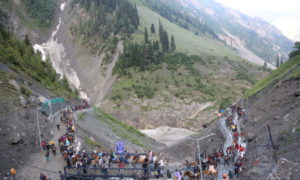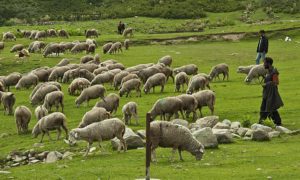Jammu: Governor N.N. Vohra, Chairman of Shri Amarnath Shrine Board (SASB), has convened an emergency meeting on January 9, 2018 to discuss the recent directions passed by the National Green Tribunal (NGT) in regard to the conduct of the Yatra and decide further course of action.
In the discussions held with CEO of SASB, legal advisors and others concerned, the strong protests over NGT’s directions, received from various social, religious and political organizations were taken note of.
It was especially pointed out that NGT had issued directions without first affording a full opportunity to the SASB to present its case. CEO stated that further legal action regarding filing of Appeal etc. shall be taken after discussions in the SASB.
ALSO READ: ‘The Militarised Yatra’: A tool to claim land and resources, notes an environmental fact-finder
It is to be recalled that the NGT, in the case titled “Gauri Maulekhi V/s State of J&K and others” had passed interim orders on 13th December, 2017 which, interalia,directed that the area from the end point of stairs to the Holy Cave shall be treated as a Silence Zone.
The Tribunal had further directed that all the directions shall be implemented without default and no Committee or Authority/Board will have the right to sit over the implementation of these directions.
However, in its subsequent order of 14th of December, 2017 the NGT clarified that there will be maintenance of silence by the devotees/ pilgrims or anybody while standing in front of Shri Amarnathji Maha Shivling and no such restriction is applicable to any other part including the main stairs leading to the Holy Cave and during the performance of daily Arti.
Further, the NGT in its order dated 13th of December, 2017 has also imposed restrictions on the carrying of material by any person, pilgrim or devotee from the last stair leading to the Cave.
NGT subsequently clarified, in its order of 14th December 2017, that interalia, this restriction would be applicable at the last proximately 30 steps leading to the Holy Cave.
In its order dated 15th of November, 2017, NGT had constituted a Committee of Experts headed by Additional Secretary, Ministry of Environment, Forests and Climate Change. This Committee has been directed to submit its report on various aspects including restrictions on the noise level.
As regards the issue of noise near the Shrine, the aforesaid Committee had recommended that the matter needs to be deliberated after proper data collection. This recommendation of the Committee of Experts was placed before NGT, in its hearing held on 13th December, 2017.
As regards the functioning of the Vaishno Devi pilgrimage, the NGT had, in its order of 13 November, 2017, interalia, directed the Shrine Board to operationalise the new 7 km Tarakote Marg, between Banganga and Adhkuwari, by 24th November 2017, and that every effort should be made not to raise any new construction at the Bhawan, and that the number of pilgrims at the Bhawan should be restricted to 50,000 per day and excess thereof should be halted either at Katra or Adhkuwari.
In view of the dateline given by the NGT in regard to the still to be completed Tarakote Marg the Shrine Board was left with no option except to file before the Supreme Court for granting extension of time for operationalisation of the Tarakote Marg till 28th February 2018, keeping in view the need to protect the safety of the Yatris.
The Supreme Court has granted a Stay Order regarding the opening of the track. The Board has also appealed against the NGT’s directions related to capping of Yatra and restrictions of new constructions at Bhawan on the grounds that it is unreasonable and premature to impose such restrictions till the ongoing Master Plan of Bhawan and extended Shrine area is finalised and approved by the Board.
The matter is awaiting further hearing in the Supreme Court.
(With inputs from CNS)








